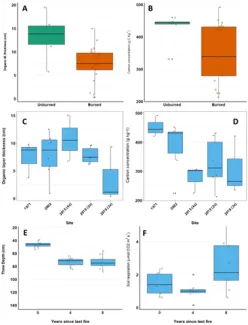Repeat tundra fire leads to carbon dioxide losses from soils overlying permafrost on the central Seward Peninsula of Alaska.
In tundra ecosystems, increased wildfire frequency and severity can alter vegetation successional trajectories and decrease the thickness of the organic layer, resulting in increased thaw depth and fluxes of carbon from the active layer of permafrost to the atmosphere compared to unburned tundra. However, the impact and timing of anticipated shifts in wildfire regimes on arctic permafrost carbon budgets remains a critical uncertainty in Earth system models. To address this uncertainty, we examined the effects of wildfire frequency and time since last wildfire on thaw depth, organic layer thickness, and soil CO2 efflux from tussock tundra on the central Seward Peninsula of AK, which has experienced several wildfires over the last 53 years (1971, 2002, 2015, and 2019), with some areas burning more than once (up to four times). We found that wildfires significantly increased thaw depth and decreased the thickness of the organic layer. Soil carbon concentration and dissolved organic carbon were significantly lower, and soil CO2 efflux was significantly higher, in sites burned more recently and more frequently. The greatest soil CO2 efflux was observed for plant communities dominated by forbs and graminoids, though this was mitigated in areas with high soil moisture content. We did not observe a significant effect of fire frequency and time since fire on soil carbon stocks due to high variability in soil bulk density values. Our results suggest that shifts in fire regimes in the Arctic towards more frequent and severe fires will increase the vulnerability of the insulating organic layer overlying tundra permafrost, accelerate the deepening of active layer thickness and loss of shallow permafrost, and increase losses of permafrost carbon as CO2.
Associated Dataset: Santos F, Breen A. 2024. Organic layer thickness and carbon concentration in burned and unburned sites at the Kougarok Fire Complex, Seward Peninsula, AK, 2022. Next-Generation Ecosystem Experiments (NGEE) Arctic, ESS-DIVE repository. https://data.ess-dive.lbl.gov/datasets/ess-dive-2f8bfca57dd73f3-20240603T165446986 on 2024-06-14.
Contacts & email addresses: Fernanda Santos (santosf@ornl.gov); Amy Breen (albreen@alaska.edu)
Effects of wildfire on tundra soil at the Kougarok Fire Complex, AK. (a) Organic layer thickness and (b) carbon concentration in burned and unburned sites; (c) Organic layer thickness and (d) carbon concentration by time since last fire and different fire frequencies (2× = twice, 3× = three times, and 4× = four times); Note that organic layer thickness did not return to unburned levels even decades after the last documented fire. (e) Thaw depth and (f) soil respiration (i.e., soil CO2 efflux) across time since last fire (0 = reference/unburned, 4 = four years since the last fire and burned three times, 8 = eight years since the last fire and burned four times). (a), (b), (c), and (d) are results associated with fieldwork in 2022, and (e) and (f) are results associated with fieldwork conducted in 2023.


